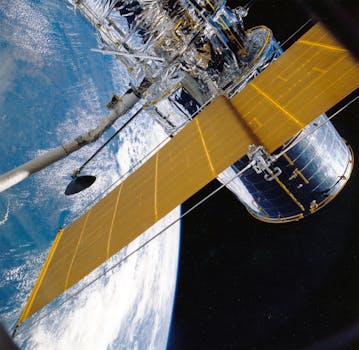The Future of Satellites: Revolutionizing Global Communication and Exploration

The Future of Satellites: Revolutionizing Global Communication and Exploration. The future of satellites holds great promise for advancing global communication, navigation, and space exploration. With rapid advancements in technology, satellites are becoming increasingly important for various industries and aspects of our lives. From providing high-speed internet access to remote areas to enabling precise navigation and timing, satellites play a vital role in our daily lives.
Satellite technology has come a long way since the launch of the first artificial satellite, Sputnik, in 1957. Today, there are thousands of satellites orbiting the Earth, and this number is expected to grow exponentially in the coming years. The increasing demand for satellite services is driven by the growing need for global connectivity, navigation, and remote sensing. As technology continues to evolve, we can expect to see significant advancements in satellite design, launch, and operation.
One of the most exciting developments in satellite technology is the emergence of small satellites, also known as CubeSats. These tiny satellites, which are typically the size of a shoebox, are designed to be low-cost, lightweight, and highly efficient. Small satellites have opened up new opportunities for startups, universities, and research institutions to develop and launch their own satellites, democratizing access to space. This has led to a proliferation of innovative satellite applications, including Earth observation, communication, and scientific research.
Advances in Satellite Propulsion and Power
Another area of significant advancement in satellite technology is propulsion and power systems. Traditional satellites rely on chemical propulsion systems, which are heavy, expensive, and have limited fuel efficiency. However, new propulsion technologies, such as electric propulsion and advanced ion engines, are being developed to improve fuel efficiency and reduce mission costs. Additionally, advances in solar panel technology and energy storage systems are enabling satellites to operate for longer periods and with greater power efficiency.
Satellite power systems are also becoming more efficient, with the development of new solar panel materials and designs. For example, the use of gallium arsenide solar cells has improved power conversion efficiency, while advancements in energy storage systems, such as lithium-ion batteries, have enabled satellites to operate for longer periods without sunlight. These advancements in propulsion and power systems are critical for enabling satellites to operate in more demanding environments, such as deep space or high-radiation orbits.
Satellite Constellations and the Internet of Things
One of the most exciting applications of satellite technology is the development of satellite constellations, which involve launching hundreds or thousands of small satellites into low Earth orbit. These constellations are designed to provide global coverage and enable a wide range of applications, including communication, navigation, and Earth observation. Satellite constellations have the potential to revolutionize the Internet of Things (IoT) by providing low-cost, low-latency connectivity to remote and underserved areas.
For example, companies like SpaceX and OneWeb are developing satellite constellations to provide high-speed internet access to remote and underserved areas. These constellations will enable a wide range of applications, including smart agriculture, remote healthcare, and emergency response. Additionally, satellite constellations will enable the development of new IoT applications, such as autonomous vehicles, smart cities, and industrial automation.
Challenges and Opportunities in the Future of Satellites
While the future of satellites holds great promise, there are also significant challenges to be addressed. One of the major challenges is the increasing congestion in Earth’s orbit, which poses a risk to satellite operations and increases the likelihood of collisions. Additionally, the growing amount of space debris in Earth’s orbit is a major concern, as it can damage or destroy operational satellites.
Despite these challenges, the future of satellites is exciting and full of opportunities. As technology continues to evolve, we can expect to see significant advancements in satellite design, launch, and operation. The development of reusable launch vehicles, such as SpaceX’s Falcon 9, has reduced the cost of access to space, making it more affordable for companies and governments to launch satellites. Additionally, advancements in materials science and manufacturing are enabling the development of more efficient and cost-effective satellites.






